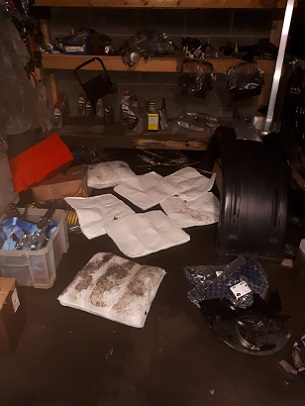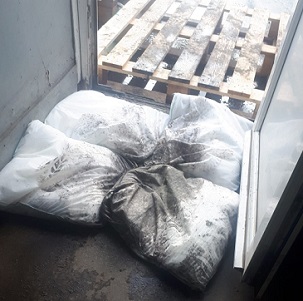 FloodSax alternative sandbags soaking up dirty floodwater at Kenneth Howley Transport Ltd in Castleford
FloodSax alternative sandbags soaking up dirty floodwater at Kenneth Howley Transport Ltd in Castleford
 FloodSax alternative sandbags protecting a door at Kenneth Howley Transport Ltd in Castleford
FloodSax alternative sandbags protecting a door at Kenneth Howley Transport Ltd in Castleford
FloodSax alternative sandbags help haulage company hit by sudden flood
FloodSax alternative sandbags were used to soak up filthy floodwater after torrential rain sent it cascading into a transport company.
The downpour quickly flooded the yard outside Kenneth Howley Transport Ltd in Castleford with around 1ft getting into the lower floor of the main building and also into the company’s garage.
Operations director Arthur Daw said: “The water even got into the inspection pits and we think the flood was mainly caused by drains outside the business being unable to cope. Some were blocked with debris and they are now in the process of being cleared out.
“We managed to get some water pumps to work and FloodSax are stored in another company’s warehouse nearby so we were quickly able to get some to soak up the rest.
“It was still raining so we used FloodSax that had been energised by the floodwater to build a protective wall to stop any more water getting in through the door. They worked very well and proved to be a great product.
“We hope a flood like this won’t happen again but we have to be realistic and so we are prepared with more FloodSax.”
FloodSax are the original alternative sandbags invented in Yorkshire in 2007 by Huddersfield-based Environmental Defence Systems Ltd and since then around 3 million have been sold worldwide.
In their dry state FloodSax resemble large pillowcases but they have a gelling polymer inside so once they’re immersed in water they absorb the water and then retain it, transforming the FloodSax into a sandless sandbag.
This means they far more environmentally friendly than traditional sandbags which tend to deteriorate and spill sand everywhere, including down drains, blocking them. FloodSax are 96% biodegradable by weight.
In their dry state 20 FloodSax fit into a cardboard box which can be easily carried by one person and several boxes will fit into a car boot. Twenty sandbags would need a pallet to shift them and just a few dozen sandbags would require a lorry to move them anywhere, along with lots of people to deploy them.
FloodSax come in packs of five so are very space-saving to store. They are used increasingly in their dry state to soak up leaks, drips, floods and spills inside homes and businesses . They are very flat with a large surface area so you can get them into the toughest spots – even under floorboards – to absorb the water until a plumber can get there to repair the problem.
Facilities managers also use them in commercial buildings to deal with leaking roofs, pipes and radiators.